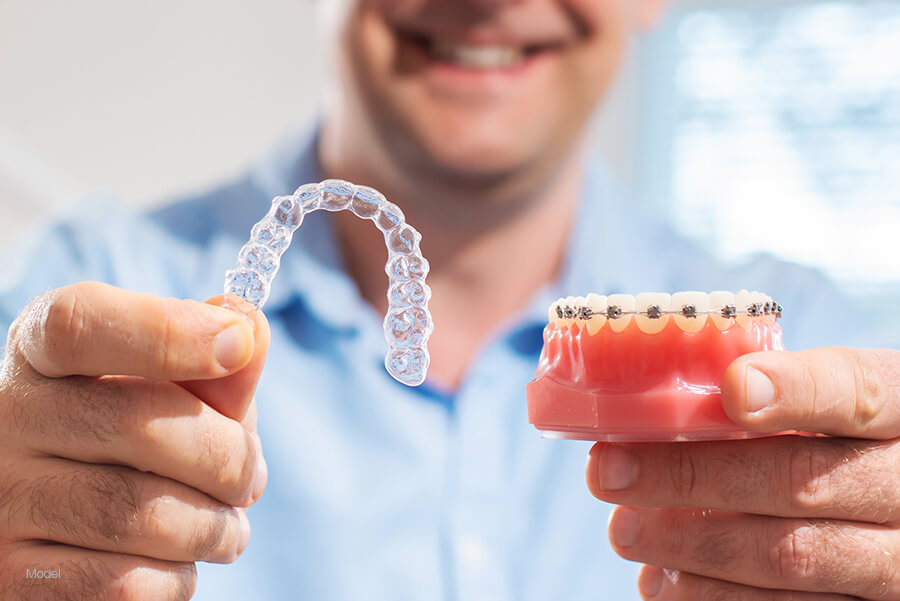
Invisalign® vs. Traditional Braces

It used to be that in order to straighten your teeth or address bite issues, your only choice was traditional braces. However, Invisalign® has changed that, giving patients another option for achieving a perfect smile. In this blog, we’ll discuss the differences between Invisalign® and traditional braces so that you can choose the most beneficial treatment for you.
5 Min Read:
Aesthetics
While most people are probably familiar with how Invisalign® and traditional braces compare aesthetically, it’s definitely worth mentioning. Invisalign® isn’t just a catchy name—for many patients, the clear, almost invisible aligners are the primary reason they choose that option over traditional metal braces. While traditional braces are available in ceramic or clear options, making them less conspicuous than metal, the brackets and wires are still more noticeable than Invisalign®.
Comfort
As anyone who has had traditional braces can attest, irritation and discomfort are things you may deal with regularly. Brackets can scrape the inside of your cheeks, and loose wires can poke the soft tissues of your mouth, making pain something you have to deal with more than you’d like. On the other hand, Invisalign® aligners are made of smooth plastic, eliminating the irritation caused by brackets and wires.
However, while Invisalign® may result in less tenderness on the inside of your mouth, invisible aligners and traditional braces can be equally uncomfortable at times. When you get your braces adjusted or switch to the next tray in your Invisalign® set, you may experience some initial soreness as your teeth adjust to their new position.
Effectiveness
Invisalign® and traditional braces can be equally effective, depending on the orthodontic issues you’re addressing. It’s true that Invisalign® can straighten your teeth and treat bite issues, but its effectiveness in treating severe orthodontic concerns is limited. Traditional braces are the best at correcting any level of orthodontic problem, so if you’re looking for a “perfect” result or have more complex misalignment or bite concerns, Invisalign® may not be the ideal solution.
Treatment Duration
In a related area, the severity of your orthodontic concerns will influence how long you need to wear your Invisalign® aligners or traditional braces. Because Invisalign® typically addresses mild to moderate issues, treatment usually lasts 12 to 18 months. Treatment with conventional braces can last from 18 months to three years, depending on the level of correction required.
It may seem tempting to choose Invisalign® over traditional braces so that you’ll have a shorter treatment time, but it really boils down to how complex your orthodontic needs are.
Convenience
Overall, Invisalign® is miles ahead of traditional braces when it comes to convenience. With Invisalign®, there are no restrictions on food or drinks—you can eat all of the chewy and crunchy foods that are off-limits with traditional braces.
However, with the convenience of Invisalign® comes a downside. Taking out your aligners to eat and drink makes it easier to lose them at a restaurant (or worse, throw them away). It also makes it easier to forget to put them back in. For Invisalign® to be effective, you must wear them 20–22 hours every day, so forgetting to put them in after meals can extend your treatment time.
Oral Hygiene
Invisalign® also makes maintaining good oral hygiene more manageable, as you can brush and floss without having to work around brackets or wires. Traditional braces can make it difficult to effectively clean your teeth, which can lead to staining, plaque buildup, cavities, and gingivitis. Invisalign® makes thoroughly cleaning your teeth (both at home and at dental checkups) easier and more convenient. Cleaning your Invisalign® aligners is easy as well, as you can brush them with a soft toothbrush and water (no toothpaste, as it can scratch them) or use a denture or retainer cleaner.
To keep your Invisalign® aligners and your teeth clean, it is recommended that you brush and floss after you eat and before you put your aligners back in. If you put your Invisalign® trays back in without cleaning your teeth, it traps the food against your teeth, allowing cavity-causing bacteria to build up. You can drink water with your Invisalign® aligners in, but you must take them out to drink anything else to avoid staining. You also need to rinse your mouth thoroughly after drinking anything other than water to keep sugars from staying on your teeth.
So, Which Is Better: Invisalign® or Traditional Braces?
While it’s clear that both Invisalign® and traditional braces each have advantages and disadvantages, determining which is better comes down to your orthodontic needs. If you simply need straighter teeth or have minor bite issues, both Invisalign® and traditional braces can work for you, and you can make a decision based on the pros and cons listed above. However, if you have more complex dental issues, your dentist will let you know which option will provide optimal correction and leave you with beautiful results.
Learn More About Invisalign® and Traditional Braces in Norridge and Schaumburg
When you’re ready to explore whether Invisalign® or traditional braces are right for you, it’s time to schedule an appointment with the expert dentists at Royal Dental Care. When you come in for a consultation, we will perform a thorough examination and offer recommendations for the type of orthodontic device that will provide the correction you need for a gorgeous smile. To see if you’re a candidate for Invisalign® or traditional braces, call us today at (773) 232-3929 (Norridge) or (847) 999-7620 (Schaumburg) or complete the online contact form.

